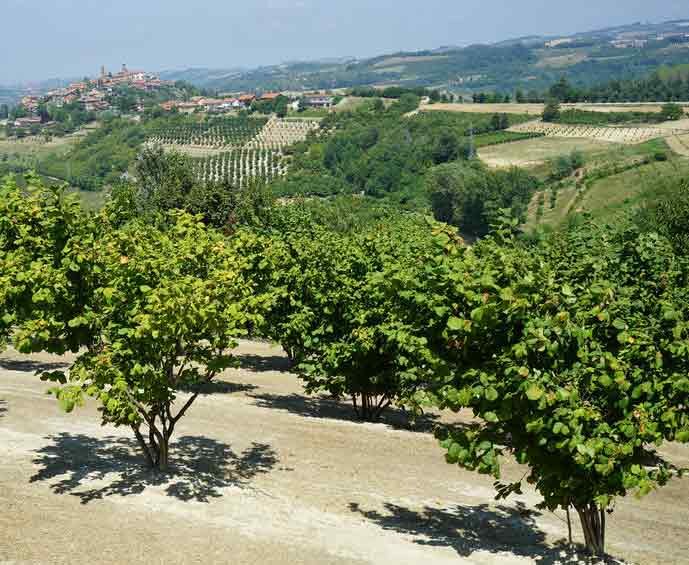Hazelnuts
High-quality bulk hazelnuts for wholesalers, distributors, suppliers and importers
HAZELNUTS: A SHORT INTRODUCTION
Archaeological evidence reveals a Mesolithic period pit full of burned hazelnut shells in Staosnaig, on the Scottish Isle of Colonsay. Hazelnuts were considered a symbol of wisdom and knowledge, as described by Greek philosophers. However, most varieties weren’t achieved until the late 19th century.
The hazelnut tree (or bush, if pruned) will grow practically anywhere, and it is impossible to say where it originates from, since different varieties appear to be native in different parts of the world. The trees prefer well-drained soil, not rich in nutrients, and are technically self-fertile. After around 4 to 5 years, they are ready for harvest, best collected in fall as soon as the husks have yellowed.
A mature, well-kept hazelnut tree can produce up to 15 kg of nuts in a single year and the main hazelnut producing countries are Turkey, Italy, USA and Greece.
NUTRITIONAL FACTS
| NUTRIENT | UNIT | VALUE PER 100G |
|---|---|---|
| Water | g | 5.31 |
| Energy | kcal | 628 |
| Protein | g | 14.95 |
| Total lipid(fat) | g | 60.75 |
| Carbohydrates, by difference | g | 16.70 |
| Fiber, total dietary | g | 9.7 |
| Sugars, total | g | 4.34 |
Hazelnuts have high protein content and are associated with a high sense of fullness that makes them recommended in weight-loss programs. Hazelnuts are an excellent source of vitamin E, which has a powerful antioxidant action, protecting body’s cells from the harmful effect of free radicals. They also contribute to the normal function of the immune system and vessels, and help generate red blood cells and the use of vitamin K in the body. Typically, 15 hazelnuts cover almost 20% of the recommended daily vitamin E intake for healthy adults. Moreover, hazelnuts have high levels of natural fiber, monounsaturated fats, which contribute to heart protection, vitamin B6 and necessary minerals and trace elements, such as potassium, magnesium, phosphorus and iron, and are also rich in antioxidants.
Products
Hazelnut Classifications Based on Size:**
Natural:
- Standard Extra: More than 15 mm
- Standard 1: 13 - 15 mm
- Standard 2: 11 - 13 mm
- Standard 3: 9 - 11 mm
- Regular: 9 - 15 mm
Blanched, Roasted:
- 11-13 mm
- 12-14 mm
- 13-15 mm
Dices (Hazelnut Pieces):
- 1-3 mm
- 2-4 mm
- 3-5 mm
These size classifications are commonly used in the hazelnut industry to categorize hazelnuts based on their size. The measurements provided indicate the diameter range of the hazelnuts in millimeters.
PACKAGING
Hazelnut Packaging Classification: Comprehensive Guide to Various Packaging Options
Discover the diverse range of packaging options available for hazelnuts in this comprehensive guide. From jute bags to paper bags, transparent to colored vacuum bags, and big bags, explore the different packaging classifications commonly used in the hazelnut industry. Learn about the various sizes and materials to ensure the optimal packaging solution for your hazelnuts.
Hazelnut Packaging Classifications:
1. Jute Bags:
- Size: 25 kg, 50 kg, 80 kg
- Material: Jute fiber
- Features: Sturdy and eco-friendly packaging option
2. Paper Bags:
- Size: 25 kg
- Material: Paper
- Features: Lightweight and convenient packaging for smaller quantities
3. Transparent, Colored, and Aluminum Vacuum Bags:
- Sizes: 5 kg, 10 kg, 12.5 kg, 20 kg, 25 kg
- Material: Transparent or colored plastic, aluminum
- Features: Vacuum-sealed to maintain freshness, option for carton packaging for added protection
4. Big Bags:
- Sizes: 500 kg, 700 kg, 800 kg, 1000 kg
- Material: Flexible woven plastic
- Features: Ideal for bulk packaging and transportation, easy to handle with lifting straps
Choose the Perfect Packaging for Your Hazelnuts:
Selecting the right packaging for your hazelnuts is crucial for maintaining their quality and freshness. Consider the quantity, transportation needs, and desired protection level when deciding on the appropriate packaging option.
HARVEST
Hazelnut Harvesting Period: When to Expect Fresh Hazelnuts from Top Producing Countries
Discover the optimal time to enjoy fresh and flavorful hazelnuts as we explore the harvesting periods in the top hazelnut producing countries. Understanding when these delectable nuts are harvested allows us to savor their natural goodness at the peak of ripeness. Join us as we delve into the hazelnut harvesting seasons across the globe.
Harvesting Periods for Hazelnuts in Top Producing Countries:
1. Turkey: Harvesting in Turkey typically takes place from August to September. During this period, hazelnuts are carefully picked when they have reached their optimum maturity, ensuring exceptional flavor and quality.
2. Italy: In Italy, hazelnuts are harvested from September to October. This timeframe aligns with the nuts’ natural maturation, guaranteeing the best taste and texture for culinary creations.
3. United States (Oregon): The hazelnut harvest in Oregon, United States, typically occurs from September to October. Growers diligently handpick the nuts when they have achieved the ideal ripeness, resulting in exceptional flavor profiles.
4. Azerbaijan: Azerbaijan’s hazelnut harvest generally spans from September to October. During this time, farmers gather the mature nuts from their orchards, ready to be enjoyed by hazelnut enthusiasts.
5. Georgia: Hazelnuts in Georgia are typically harvested from September to October. The cool autumn climate facilitates the nuts’ natural maturation, ensuring the finest quality for consumers.
Enjoy Fresh Hazelnuts at the Peak of Flavor:
By knowing the hazelnut harvesting periods in these top producing countries, you can indulge in the irresistible taste of freshly harvested nuts. Plan your culinary adventures and savor the delightful flavors that coincide with the peak harvest seasons.
KEY POINTS
Here are some key points based on the total supply comparison per country:
- Turkey experienced a significant increase in total supply from 467,800 metric tons in 2022/2023 to 512,500 metric tons in 2023/2024, marking a +9.55% growth.
- Italy saw a moderate rise in total supply, reaching 53,850 metric tons in 2023/2024 compared to 51,700 metric tons in 2022/2023, reflecting a +4.15% increase.
- The USA witnessed a slight growth in total supply, reaching 36,100 metric tons in 2023/2024 compared to 33,900 metric tons in 2022/2023, indicating a +6.49% rise.
- Chile experienced a stable total supply of 27,950 metric tons for both 2022/2023 and 2023/2024 crop seasons.
- Azerbaijan observed a small decrease in total supply, reaching 27,280 metric tons in 2023/2024 compared to 26,400 metric tons in 2022/2023, showing a -3.34% decline.
- Georgia's total supply remained consistent at 19,000 metric tons for both 2022/2023 and 2023/2024 crop seasons.
- China witnessed a minor decline in total supply, reaching 13,780 metric tons in 2023/2024 compared to 13,850 metric tons in 2022/2023, indicating a -0.50% decrease.
- Spain maintained a stable total supply of 12,750 metric tons for both 2022/2023 and 2023/2024 crop seasons.
- Iran experienced a slight decrease in total supply, reaching 7,870 metric tons in 2023/2024 compared to 7,600 metric tons in 2022/2023, reflecting a -3.55% decline.
- France observed a consistent total supply of 4,000 metric tons for both 2022/2023 and 2023/2024 crop seasons.
These key points highlight the changes in total supply for various hazelnut-producing countries, showcasing growth, stability, and slight declines in different regions.
TOP PRODUCING COUNTRIES
Top Hazelnut Producing Countries: A Global Overview
Welcome to our comprehensive guide on the top hazelnut producing countries worldwide. Hazelnuts, known for their rich flavor and versatility, are a popular ingredient in various culinary creations. Understanding the leading hazelnut-producing countries is essential for industry professionals, consumers, and enthusiasts alike. Join us as we explore the top countries driving the global hazelnut industry.
Top Hazelnut Producing Countries:
1. Turkey: With its abundant hazelnut orchards in the Black Sea region, Turkey stands as the largest producer of hazelnuts globally. Its favorable climate and expertise in hazelnut cultivation contribute to the country’s dominant position in the market.
2. Italy: Italy, particularly the Piedmont region, is renowned for its high-quality hazelnuts. Italian hazelnuts are sought after for their superior flavor and are used extensively in confectionery and pastry products.
3. United States: Oregon, in the United States, is a significant hazelnut producer. The state’s ideal growing conditions and commitment to sustainable farming practices result in top-quality hazelnuts enjoyed by consumers worldwide.
4. Azerbaijan: Emerging as an important player in the hazelnut industry, Azerbaijan benefits from its favorable climate and extensive hazelnut orchards. The country’s production has been steadily increasing, contributing to the global hazelnut supply.
5. Georgia: Georgia boasts a rich tradition of hazelnut production, particularly in its western region. Georgian hazelnuts are known for their exceptional quality and are a vital part of the country’s agricultural sector.
Other Notable Hazelnut Producing Countries:
• Spain
• France
• Iran
• Greece
• Germany
Please note that hazelnut production can vary from year to year due to factors such as weather conditions and market dynamics. Stay informed about the latest trends and developments in the hazelnut industry for a comprehensive understanding.
Turkey is the world largest producer of hazelnuts
Hazelnut Orchard - Italy
Hazelnuts growing
Hazelnut and Chocolate paste
hazelnut milk has become a popular alternative to dairy









